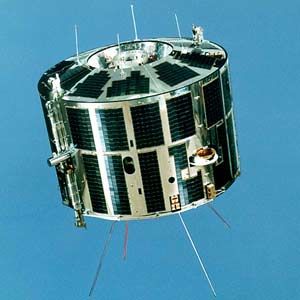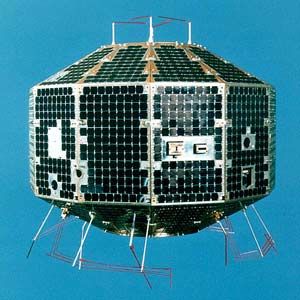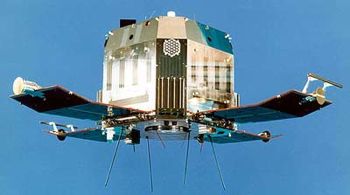
Home - Search - Browse - Alphabetic Index: 0- 1- 2- 3- 4- 5- 6- 7- 8- 9
A- B- C- D- E- F- G- H- I- J- K- L- M- N- O- P- Q- R- S- T- U- V- W- X- Y- Z
EXOS
 SS-05 Kyokko Credit: Manufacturer Image |
AKA: Akebono. Status: Operational 1978. First Launch: 1978-02-04. Last Launch: 1989-02-21. Number: 4 . Gross mass: 126 kg (277 lb).
Optical study of the stratosphere and middle atmosphere. Study of the specific phenomena of the ionospheric plasma over the southern Atlantic geomagnetic anomaly zone which was discovered by the third scientific satellite "TAIYO". Launch vehicle Mu-3S-4, launching organization ISAS (Institute of Space and Astronautical Science).
More at: EXOS.
| Exos B (Jikiken) Null |
| Exos C (Ohzora) Null |
| Exos D (Akebono) Null |
Family: Earth, Ionosphere sat. Country: Japan. Launch Vehicles: Mu, Mu-3H, Mu-3S, Mu-3S-II, Mu-3. Launch Sites: Kagoshima, Kagoshima M. Bibliography: 2, 279, 6, 6490, 12370, 12371, 12372, 12373.
 | SS-06 Jikiken Credit: Manufacturer Image |
 | SS-09 Onzora Credit: Manufacturer Image |
 | Akebono Credit: Manufacturer Image |
1978 February 4 - . 07:00 GMT - . Launch Site: Kagoshima. Launch Complex: Kagoshima M. LV Family: Mu. Launch Vehicle: Mu-3H.
- SS-05 Kyokko - .
Payload: Exos A. Mass: 103 kg (227 lb). Nation: Japan.
Agency: ISAS.
Class: Earth.
Type: Ionosphere satellite. Spacecraft: EXOS.
USAF Sat Cat: 10664 . COSPAR: 1978-014A. Apogee: 3,952 km (2,455 mi). Perigee: 639 km (397 mi). Inclination: 65.40 deg. Period: 134.00 min.
Auroral studies. Active life - two years. Function: 1) Observation of wide angle global auroral pictures using UV television camera. 2) Spectrophotometry of ultraviolet air glow. 3) Observation of the energy spectrum of photoelectrons and auroral electrons. 4) Mass spect rometry of the ionized atmospheric species in the thermosphere. 5) Measurements of density and temperature of ambient electrons in the thermosphere. 6) Observation of electromagnetic and plasma waves and the emission associated with auroral phenomena.
1978 September 16 - . 05:00 GMT - . Launch Site: Kagoshima. Launch Complex: Kagoshima M. LV Family: Mu. Launch Vehicle: Mu-3H.
- SS-06 Jikiken - .
Payload: Exos B. Mass: 100 kg (220 lb). Nation: Japan.
Agency: ISAS.
Class: Earth.
Type: Ionosphere satellite. Spacecraft: EXOS.
Decay Date: 2018-04-23 . USAF Sat Cat: 11027 . COSPAR: 1978-087A. Apogee: 21,192 km (13,168 mi). Perigee: 251 km (155 mi). Inclination: 31.30 deg. Period: 370.90 min.
Launching organization: Institute of Space and Aeronautical Science, University of Tokyo. Stimulated plasma wave experiment, natural plasma wave measurement, plasma parameter measurement by VLF Doppler technique, electric field probe and plasma density me asurement, energetic particle analysis, and controlled electron beam emission experiment. Characteristics: weight 90.5 kg, configuration - polyhedron with 38 faces, height 0.6m , diameter 0.75m, attitude control spin stabilization, life two years.
1984 February 14 - . 08:00 GMT - . Launch Site: Kagoshima. Launch Complex: Kagoshima M. Launch Pad: M1. LV Family: Mu. Launch Vehicle: Mu-3S.
- SS-09 Onzora - .
Payload: Exos C. Mass: 180 kg (390 lb). Nation: Japan.
Agency: ISAS.
Class: Earth.
Type: Ionosphere satellite. Spacecraft: EXOS.
Decay Date: 1988-12-26 . USAF Sat Cat: 14722 . COSPAR: 1984-015A. Apogee: 331 km (205 mi). Perigee: 247 km (153 mi). Inclination: 74.60 deg. Period: 90.30 min.
Optical investigations of ionosphere. EXOS-C (OHZORA). Optical study of the stratosphere and middle atmosphere. Study of the specific phenomena of the ionospheric plasma over the southern Atlantic geomagnetic anomaly zone which was discovered by the third scientific satellite 'TAIYO'. Launch vehicle Mu-3S-4, launching organization ISAS (Institute of Space and Astronautical Science). Launch time 0800 GMT.
1989 February 21 - . 23:30 GMT - . Launch Site: Kagoshima. Launch Complex: Kagoshima M. Launch Pad: M1. LV Family: Mu. Launch Vehicle: Mu-3S-II.
- Akebono - . Payload: Exos D. Mass: 295 kg (650 lb). Nation: Japan. Agency: ISAS. Class: Earth. Type: Ionosphere satellite. Spacecraft: EXOS. USAF Sat Cat: 19822 . COSPAR: 1989-016A. Apogee: 8,554 km (5,315 mi). Perigee: 272 km (169 mi). Inclination: 75.10 deg. Period: 185.90 min. Studied aurora borealis, auroral australis. EXOS-D (Akebono). Observation in high precision of behaviour and acceleration mechanism of aurora particles in Earth magnetosphere. Launching organization ISAS. Launch time 2330 GMT. .
Back to top of page
Home - Search - Browse - Alphabetic Index: 0- 1- 2- 3- 4- 5- 6- 7- 8- 9
A- B- C- D- E- F- G- H- I- J- K- L- M- N- O- P- Q- R- S- T- U- V- W- X- Y- Z
© 1997-2019 Mark Wade - Contact
© / Conditions for Use